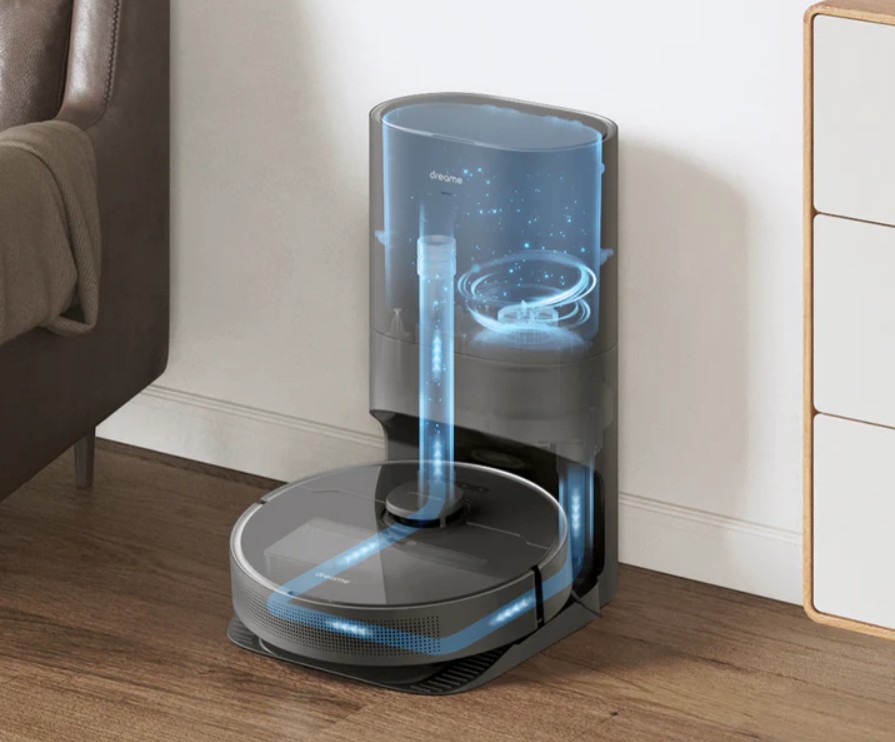You only have a certain number of hours in a day, and floor care often steals more time than you’d like—especially when rounds leave crumbs along skirting boards, carpets get damp while mopping, or you have to stop to empty the bin or rinse the mops. Intelligent robot vacuums are designed to remove friction. Combining precise mapping, obstacle management, carpet-smart mopping and automation in the base station, they keep floors evenly presentable without you having to watch all the time. The result is fewer rounds again, fewer rescue operations and less mental strain. The market now offers mature alternatives in several price ranges, including solutions such as Dreame robot vacuum cleaners, which emphasize automated maintenance and reliable navigation.
What to know before choosing
A good system reduces how often you have to intervene—not just how hard it vacuums. Look for three pillars: a dock that takes care of routine tasks; intelligence in the robot that accurately maps and avoids common obstacles; and an app that lets you control times, rooms, and exceptions without a babysitter. This is precisely what many modern product lines—such as Dreame robot vacuums—excel at: the combination of self-emptying, washing and wiping the mops, and carpet-smart logic minimizes tasks you would otherwise do by hand, while keeping the results smooth.
Definition and scope
An intelligent cleaning system connects sensors, software, and automation to vacuum and mop with minimal supervision. The robot handles navigation and dirt collection; The base station empties the dust bin, washes and dries mop pads, and (on select models) refills water so the robot is ready for the next session. In the app, fine-tune maps, set spatial routines, and plan the pace that suits your week.
System Components and Automation Layer
- Dock/Base Automation: Self-emptying collects debris in a closed bag, and advanced docks wash and dry the mop pads so you don’t have to do hand rinsing after each session.
- Robot intelligence: Obstacle sensors, edge and corner behavior, carpet detection, and mop lift allow the robot to move efficiently on mixed floor types.
- App layers: Multi-level maps, quiet periods, no-zones/no-mop zones, and routines for rooms that get dirty faster (kitchen after dinner, hallway after school).
Automation that reduces routine tasks
Dockpage Automation
A self-emptying base means you don’t have to pause a session to deal with dust. When the dock also washes and hot air dries the mops, you can complete a full clean without rinsing pads in the sink. Small wins like this add up to a lot—you set a plan and let the system do the work.
Maintenance intervals and consumables
When the dock takes care of the messy tasks, brushes and mop pads stay usable longer, and you can follow app notifications to change consumables on time. Some docks can also refill water automatically, cutting even more week-to-week tasks.
Intelligent navigation and scheduling
Route selection, mapping, and obstacle management
Great results start with great maps. Modern robots create detailed floor plans, detect obstacles, and plan routes that reduce both omitted streaks and double-travel. In practice, you’ll see fewer “jam” situations and more even coverage—especially in busy zones and around furniture.
App-based controls, routines, and integrations
You can map several floors, plan quiet runs, set zone cleaning for the kitchen or make the hallway a daily priority. Many models also work with popular voice assistants, so you can start or pause when your hands are busy.
Floor Type Awareness
Carpet recognition and mop lift logic
Mixed floors are where the intelligence really pays off. Ultrasonic carpet recognition marks carpets, then the robot raises the mop pads or avoids the area during mopping and increases the suction on carpet during vacuuming. There’s no need to remove mops or change modes between rooms—the robot adapts continuously.
If you want a clear starting point when comparing configurations, you can see the official collection of Dreame robot vacuums. Filter on all-in-one dock, carpet recognition with mop lift, and map features to fit your floor plan.
Range along edges and corners
Edge-optimized mechanisms
Edges and tight corners are classic weaknesses. Look for side brushes and software passes that follow along the skirting boards following the main routes. The difference is shown where crumbs tend to remain—kick plates, chair legs, and door frames.
Fewer stop and fix events
Anti-tangle brush and waste management
Rubberized, tangle-preventing main brushes help prevent hair from tangling, so you spend less time cutting loose hairs. Automatic suction increase on carpet moves dirt on to the bin instead of stopping in the brush housing.
Overcoming thresholds and obstacles
Homes have cables, toys, and door thresholds. Models that cope with moderate thresholds and recognize common objects in advance complete multiple sessions without rescue. If your home has level differences or one-step transitions, you should check each candidate’s specifications for obstacle management and available accessories.
Increased efficiency and power management
Runtime, Loading, and Scheduling
Efficient routing allows a robot to cover more area per charge. When the battery gets low, it returns to the dock, recharges, and picks up where it left off—goodbye reboots in the middle of cleaning. If you add regular routines—daily kitchen cleaning, weekly thorough sessions—you maintain a stable level without weekend catch-up.
Factors affecting capacity
Capacity depends on map quality, clutter and obstacle density, as well as your settings (one vs. two passes, vacuuming only vs. vacuuming and mopping). Clear the floor whenever you can; The robot takes care of the rest.
Customizing Features for Environments
| Usage environment | Useful features | Why it matters |
| Private residence with mixed floors | Ultrasonic carpet recognition with mop lift; zone cleaning | Keeps carpets dry and allows you to prioritize your kitchen and bathroom more often. |
| Small offices | Self-emptying dock; reliable obstacle management; scheduled sessions | Handles dust from foot traffic and can run after closing time unattended. |
| Hotels & Shared Areas | Edge Reach Optimization; Reliable Mapping; Simple Consumables | Improves coverage along skirting boards, keeps routes predictable, and simplifies maintenance for employees. |
Conclusion
When a robot vacuum does more of the work between rounds—emptying itself, washing and drying the mops, mapping accurately, adapting to carpets, and reaching for edges—you get back your time and energy. Focus on the features that suit your floors and routines, and you’ll notice the difference within a week. When creating a shortlist, include modern product lines from Dreame along with other options and filter on the features above; Then you end up with a solution that keeps your space clear without stealing your attention.






